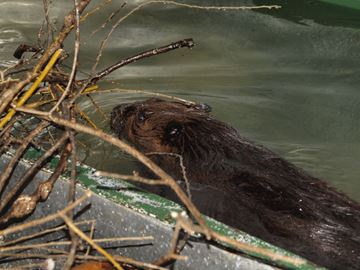 If you missed our exciting CT debut you can check out the podcast and learn about the guests here. The beginning of the program is a little excessively whimsical, but it’s a pretty awesome listen overall. I was so happy to learn Sherri was going to be on at the end, and thrilled when the host rightfully called her “the Bruce Springsteen of Beaver Trapping”. I’m not unhappy with my performance. I did an okay job of saying what I wanted to say regardless of whatever silly question was asked. (A trick politicians innately seem to have, but is hard for us compliant folks to learn.) It was very hard to hear on the phone, and I was straining ever muscle to make sure I followed what they were saying, even with the dog locked outside and the volume up.
If you missed our exciting CT debut you can check out the podcast and learn about the guests here. The beginning of the program is a little excessively whimsical, but it’s a pretty awesome listen overall. I was so happy to learn Sherri was going to be on at the end, and thrilled when the host rightfully called her “the Bruce Springsteen of Beaver Trapping”. I’m not unhappy with my performance. I did an okay job of saying what I wanted to say regardless of whatever silly question was asked. (A trick politicians innately seem to have, but is hard for us compliant folks to learn.) It was very hard to hear on the phone, and I was straining ever muscle to make sure I followed what they were saying, even with the dog locked outside and the volume up.
I weirdly never feel stressed during the actual event, but I was a basket case the rest of the day, so I guess it does take something out of you. The amazingly well-spoken caller from East Haddam, CT, was echoed by almost the exact same comment on this website from Pennsylvania. Did you see? Telling people on the East coast that we can live with beaver has amazing results. I loved the genuine interest and education of the producer and the host, who contacted me after to say thanks and make sure they hadn’t posted nutria pictures. And Sherri called me excited after the interview and wanted to kvetch about all the things we didn’t get to say. Not missing any opportunities, I then boldly wrote and thanked both authors, asking for copies of their books for the silent auction. It was quite the morning.
 No resting on our laurels, time marches on, and yesterday I noticed this photo leading an article about mink farming in Nova Scotia. The article quotes our friends at Furbearer Defenders and criticizes mink farms for being unsanitary. But its righteous message is compromised by its inherent plagierism. Maybe the photo seems familiar to you? Or maybe you didn’t recognize it without CREDIT to our own Cheryl Reynolds? I wrote the editor and the reporter so we’ll see if it gets credited soon.
No resting on our laurels, time marches on, and yesterday I noticed this photo leading an article about mink farming in Nova Scotia. The article quotes our friends at Furbearer Defenders and criticizes mink farms for being unsanitary. But its righteous message is compromised by its inherent plagierism. Maybe the photo seems familiar to you? Or maybe you didn’t recognize it without CREDIT to our own Cheryl Reynolds? I wrote the editor and the reporter so we’ll see if it gets credited soon.
In the meantime there’s this charming appreciation of beavers from an outdoor column in Illinois.
 Since the early 1960s I have been amazed with beavers.
Since the early 1960s I have been amazed with beavers.
Before that we had no giant rodents in our state so this was an all new animal. As they became more numerous, many farmers loved to see them and became very protective of any that built dams on their waterways. In fact many farms that contained beaver colonies became a sightseeing event for many folks.
Is that true that Illinois didn’t reintroduce beaver until the 60’s? That would be very surprising. But reading through his column I see that he is largely unburdened by facts or research of any kind. He emphatically states that beavers were easy to wipe out because they only have two kits every year. And that they fell trees and eat the entire thing, all the way to the top.
Well, okay then. Maybe not the 60’s.
Ice conditions make trapping very dangerous and hard work. After catching a large beaver, there is a lot of work to get them ready for market. The animal must be skinned, fleshed (all the fat removed) and placed on a round stretcher to dry. This results in several hours of hard work. The hourly rate doesn’t attract many trappers.
When I was at the beaver festival in Utah I had an interesting conversation with Mary about the Utah trapping association. She had invited them to the event and they brought furs for the children to touch. Mary was especially impressed by one trapper who explained that ‘beavers are really good for the creek! They make all this wildlife!’ and she admonished her students to spend more time talking to them. Because you can’t only talk to people who agree with you. And they could learn things.
Which is true. I agree 100% with the concept. Someone should have many conversations with trappers, wardens and invite their local technicians from APHIS for a beer.
Someone else.









 People should envy the beaver for its winter set-up – a cozy cottage stocked with wood, food and family
People should envy the beaver for its winter set-up – a cozy cottage stocked with wood, food and family

![378985233_tp[1]](https://www.martinezbeavers.org/wordpress/wp-content/uploads/2014/11/378985233_tp1.jpg)








































